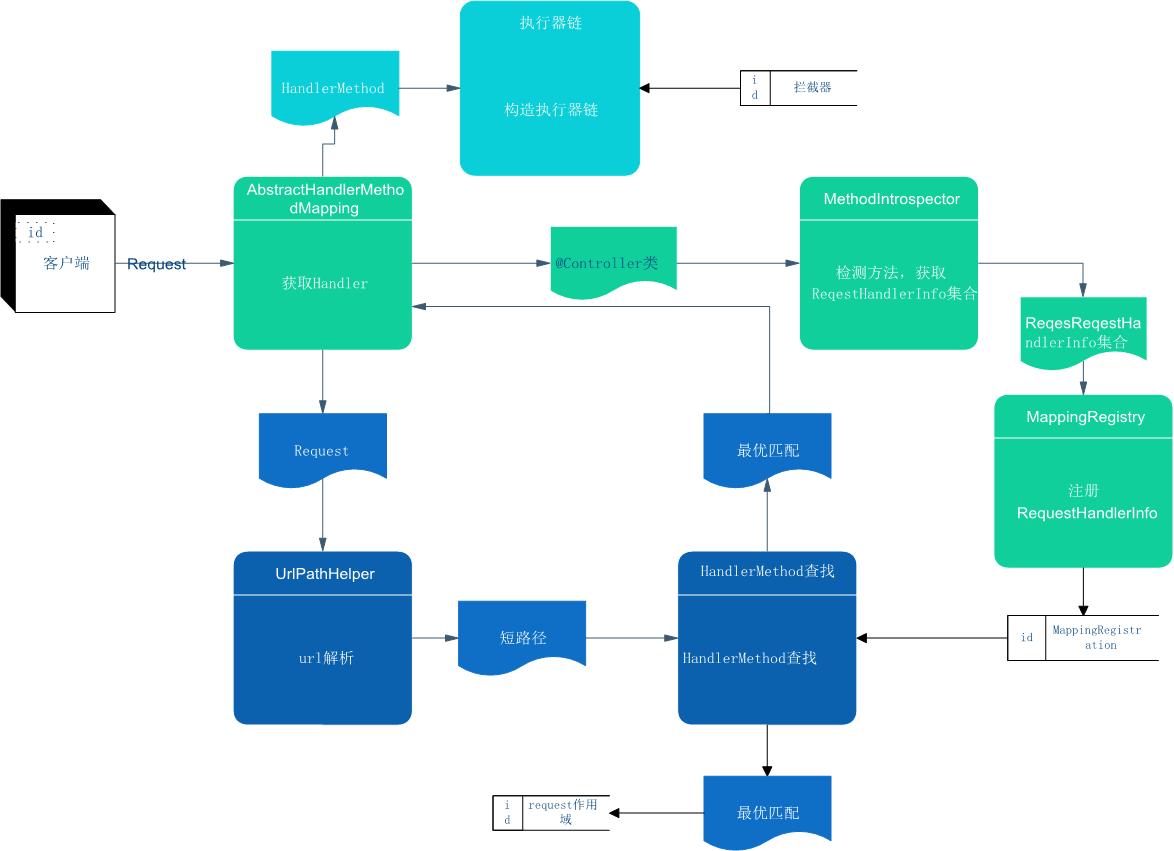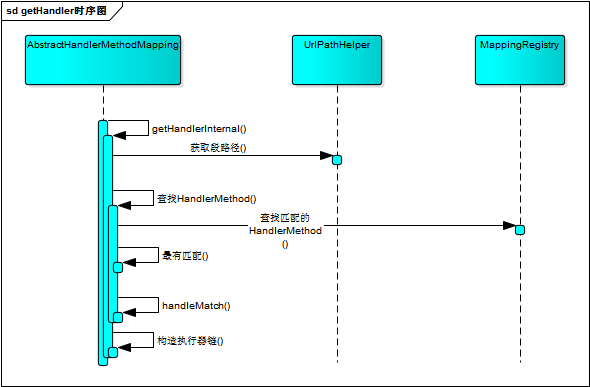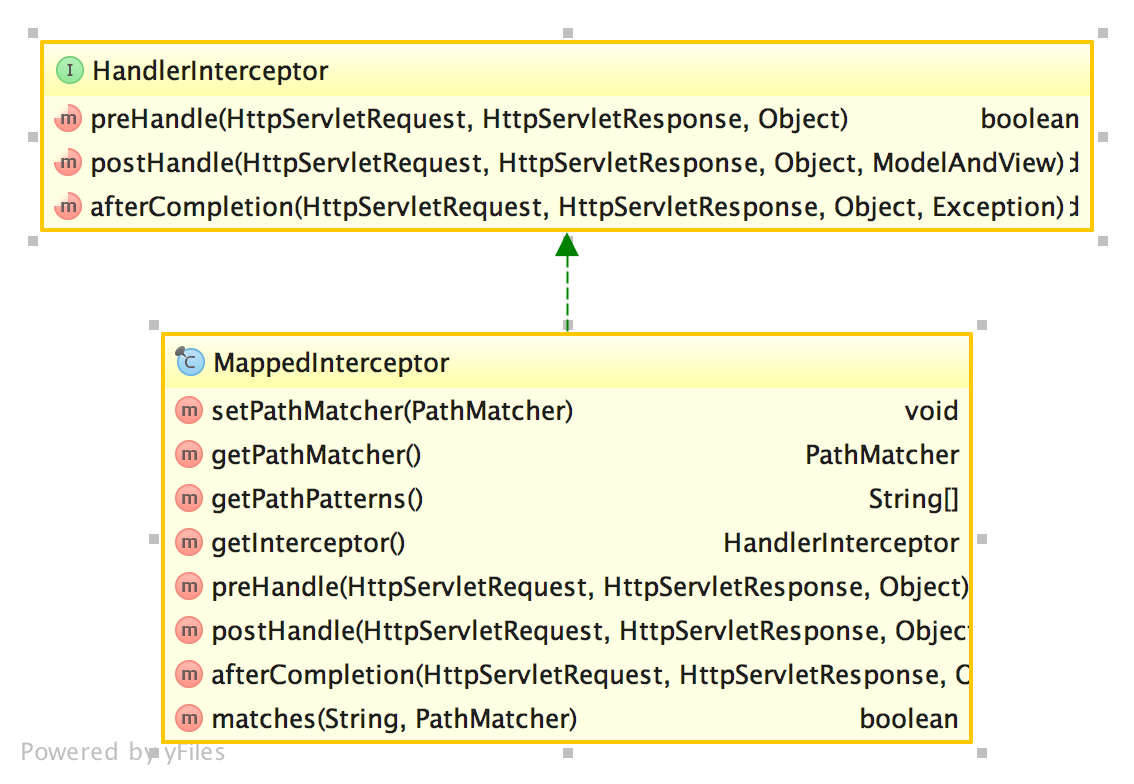HandlerMapping 详解
1. 导言
万丈高楼平地起,SpringMVC的辉煌离不开每个组件的相互协作,上一章详细阐述了SpringMVC整个体系结构及实现原理,知道HandlerMapping在这个SpringMVC体系结构中有着举足轻重的地位,充当着url和Controller之间映射关系配置的角色。主要有三部分组成:HandlerMapping映射注册、根据url获取对应的处理器、拦截器注册。本文将立足于RequestMappingHandlerMapping详细阐述HandlerMapping的整个体系。其结构如图所示。

笔者可以以不同颜色表示三大主要过程,下面笔者将逐步分析RequestMappingHandlerMapping的整个体系。
2. 检测方法,构造RequestHandlerInfo映射集合
- AbstractHandlerMethodMapping一个并不陌生的方法,afterPropertiesSet()
注意AbstractHandlerMethodMapping继承自InitializingBean,会在Bean初始化完成后调用afterPropertiesSet()方法
@Override
public void afterPropertiesSet() {
initHandlerMethods();
}
initHandlerMethods的实现如下图所示:

判断beanType是否是满足要求的handler和检测并生存handlerMethod是最为关键的两个过程。其中判断是否满足要求的handler,实现如下:
protected abstract boolean isHandler(Class<?> beanType);
@Override
protected boolean isHandler(Class<?> beanType) {
return (AnnotatedElementUtils.hasAnnotation(beanType, Controller.class) ||
AnnotatedElementUtils.hasAnnotation(beanType, RequestMapping.class));
}
注意到,isHandler方法是一个抽象方法,在父类不能确定如何实现,这边将具体的实现交子类来进行,在 RequestMappingHandlerMapping中的实现为只要有@Controller注解或者@RequestMapping注解的均为满足要求的handler。
检测HandlerMethods是在detectHandlerMethods方法中实现的,其几个关键的类、接口及方法实现如图所示:

detectHandlerMethods的实现序列图如图所示

- what?selectMethods感觉好凌乱,这么复杂,是否有跟笔者一样的想法?
selectMethods其实是两个命令模式的变体的叠加。笔者看来每个设计模式都有多种变体,重要的是理解每个设计模式解决的问题。命令模式的主要目的是为了将触发和命令的具体实现解耦,以实现触发命令操作和具体的命令的实现相互隔离。当命令触发时,命令对象就会执行操作,这是java事件的处理方式。java中典型的命令模式,就是多线程的start方法和Runnable的run方法,相信读者并不会陌生。
Thread thread = new Thread(new Runnable(){
@Override
public void run(){
log.info("简单的测试");
}
});
...
thread.start();
首先传入一个命令对象,这个命令(run方法)并不会立马执行,会在事件触发后才会调用命令(start方法),但在什么时候触发事件,在传入命令对象的时候,我们并不关心,也没办法知道如何触发事件。
简单解释了命令模式,解决的问题,现在回到主题,selectMethods是怎么实现的?
第一个命令模式:
public interface MetadataLookup<T> {
/**
* Perform a lookup on the given method and return associated metadata, if any.
* @param method the method to inspect
* @return non-null metadata to be associated with a method if there is a match,
* or {@code null} for no match
*/
T inspect(Method method);
}
Map<Method, T> methods = MethodIntrospector.selectMethods(userType,
new MethodIntrospector.MetadataLookup<T>() {
@Override
public T inspect(Method method) {
try {
return getMappingForMethod(method, userType);
}
catch (Throwable ex) {
throw new IllegalStateException("Invalid mapping on handler class [" +
userType.getName() + "]: " + method, ex);
}
}
});
传入一个命令,MetadataLookup的实现,在selectMethods方法内部会调用对象的inspect方法。(实际上是在第二命令中调用的这个命令)。
第二个命令模式:
public interface MethodCallback {
/**
* Perform an operation using the given method.
* @param method the method to operate on
*/
void doWith(Method method) throws IllegalArgumentException, IllegalAccessException;
}
for (Class<?> currentHandlerType : handlerTypes) {
final Class<?> targetClass = (specificHandlerType != null ? specificHandlerType : currentHandlerType);
ReflectionUtils.doWithMethods(currentHandlerType, new ReflectionUtils.MethodCallback() {
@Override
public void doWith(Method method) {
Method specificMethod = ClassUtils.getMostSpecificMethod(method, targetClass);
T result = metadataLookup.inspect(specificMethod);
if (result != null) {
Method bridgedMethod = BridgeMethodResolver.findBridgedMethod(specificMethod);
if (bridgedMethod == specificMethod || metadataLookup.inspect(bridgedMethod) == null) {
methodMap.put(specificMethod, result);
}
}
}
}, ReflectionUtils.USER_DECLARED_METHODS);
}
传入一个命令,MethodCallback的实现,在doWithMethods方法内部会调用对象的dowith方法方法。
- 再谈selectMethods实现
第一个命令模式,即selectMethods方法中,
(1)首先选择所有HandlerType的所有继承体系的所有class:
final Map<Method, T> methodMap = new LinkedHashMap<Method, T>();
Set<Class<?>> handlerTypes = new LinkedHashSet<Class<?>>();
Class<?> specificHandlerType = null;
if (!Proxy.isProxyClass(targetType)) {
handlerTypes.add(targetType);
specificHandlerType = targetType;
}
handlerTypes.addAll(Arrays.asList(targetType.getInterfaces()));
(2)遍历每一个handlerType
(3)选择每一个满足要求的方法,执行dowith方法
public static void doWithMethods(Class<?> clazz, MethodCallback mc, MethodFilter mf) {
// Keep backing up the inheritance hierarchy.
Method[] methods = getDeclaredMethods(clazz);
for (Method method : methods) {
if (mf != null && !mf.matches(method)) {
continue;
}
try {
mc.doWith(method);
}
catch (IllegalAccessException ex) {
throw new IllegalStateException("Not allowed to access method '" + method.getName() + "': " + ex);
}
}
if (clazz.getSuperclass() != null) {
doWithMethods(clazz.getSuperclass(), mc, mf);
}
else if (clazz.isInterface()) {
for (Class<?> superIfc : clazz.getInterfaces()) {
doWithMethods(superIfc, mc, mf);
}
}
}
public static final MethodFilter USER_DECLARED_METHODS = new MethodFilter() {
//只选择用户定义的方法,Object方法和代理方法不满则需求
@Override
public boolean matches(Method method) {
return (!method.isBridge() && method.getDeclaringClass() != Object.class);
}
};
(4)针对每一个method调用metadataLookup的dowith方法,以{method,result}的形式缓存:
public void doWith(Method method) {
Method specificMethod = ClassUtils.getMostSpecificMethod(method, targetClass);
T result = metadataLookup.inspect(specificMethod);
if (result != null) {
Method bridgedMethod = BridgeMethodResolver.findBridgedMethod(specificMethod);
if (bridgedMethod == specificMethod || metadataLookup.inspect(bridgedMethod) == null) {
methodMap.put(specificMethod, result);
}
}
}
(5)重头戏,inspect方法
public T inspect(Method method) {
try {
return getMappingForMethod(method, userType);
}
catch (Throwable ex) {
throw new IllegalStateException("Invalid mapping on handler class [" +
userType.getName() + "]: " + method, ex);
}
}
其关键之关键为getMappingForMethod,首先会读取方法上的@RequestMapping注解,然今读取类上面的注解,最后进行联合操作。
protected RequestMappingInfo getMappingForMethod(Method method, Class<?> handlerType) {
RequestMappingInfo info = createRequestMappingInfo(method);
if (info != null) {
RequestMappingInfo typeInfo = createRequestMappingInfo(handlerType);
if (typeInfo != null) {
info = typeInfo.combine(info);
}
}
return info;
}
(6)注册RequestMappingInfo
Method invocableMethod = AopUtils.selectInvocableMethod(entry.getKey(), userType);
T mapping = entry.getValue();
registerHandlerMethod(handler, invocableMethod, mapping);
registerHandlerMethod会调用MappingRegistry的registry方法,其实现流程如图所示

这个过程主要针对HandlerMethod做了一些缓存,方便查询,根据url,name,mapping均做了相应缓存,主要是为了优化查询handlerMethod的性能。
3. getHandler方法,获取执行器链。
- 获取执行器链入口:
mappedHandler = getHandler(processedRequest);
protected HandlerExecutionChain getHandler(HttpServletRequest request) throws Exception {
for (HandlerMapping hm : this.handlerMappings) {
if (logger.isTraceEnabled()) {
logger.trace("Testing handler map [" + hm + "] DispatcherServlet with name '" + getServletName() + "'");
}
HandlerExecutionChain handler = hm.getHandler(request);
if (handler != null) {
return handler;
}
}
return null;
}
遍历配置的handlerMappings,依次调用getHandler方法,只要找到满足要求的handlerMapping,立马返回。
- HandlerMapping的getHandler方法:

查找到匹配项后,handlerMethod做一些处理,RequestHandlerMethodMapping是会将相关内容缓存在request域中,当然,使用的时候也可以定制一些内容。笔者猜想,这些都是为了性能提升而努力的,毕竟性能提升在每一小步。
构造执行器链,执行器链中包含HandlerMethod和相关拦截器,同时包含有跨域的解决方案。
protected HandlerExecutionChain getHandlerExecutionChain(Object handler, HttpServletRequest request) {
HandlerExecutionChain chain = (handler instanceof HandlerExecutionChain ?
(HandlerExecutionChain) handler : new HandlerExecutionChain(handler));
String lookupPath = this.urlPathHelper.getLookupPathForRequest(request);
for (HandlerInterceptor interceptor : this.adaptedInterceptors) {
if (interceptor instanceof MappedInterceptor) {
MappedInterceptor mappedInterceptor = (MappedInterceptor) interceptor;
if (mappedInterceptor.matches(lookupPath, this.pathMatcher)) {
chain.addInterceptor(mappedInterceptor.getInterceptor());
}
}
else {
chain.addInterceptor(interceptor);
}
}
return chain;
}
4. 再谈拦截器
从上一节的代码可以看出,拦截器至少包含两种,实现MappedInterceptor和实现普通HandlerInterceptor接口的类。

普通handler接口,会直接加入到拦截器链中,而MappedInterceptor则只会加入matches方法返回true的拦截器。
至此HandlerMapping已分析完毕,SpringMVC的其它内容也将陆续推出。